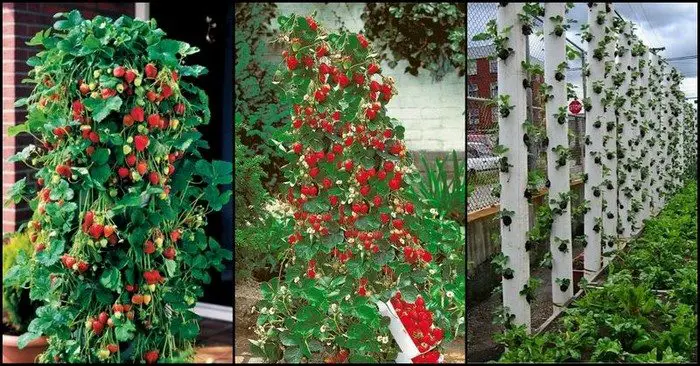If you’re looking for an innovative and space-saving gardening solution, a DIY PVC pipe planter is just what you need. This creative project allows you to transform ordinary PVC pipes into a functional and stylish vertical garden.
Whether you have a small balcony, limited yard space, or simply want to add a unique touch to your garden, this DIY project is perfect for you.
In this guide, we will walk you through the steps to build your own DIY PVC pipe vertical planter and unleash your creativity in designing a beautiful and flourishing garden.
Contents
Getting Started With DIY PVC Pipe Planter
With a DIY PVC pipe planter, you can take advantage of vertical spaces that often go unused. By going vertical, you maximize your gardening area without sacrificing valuable floor space.
Transform your walls, fences, or even balconies into thriving green spaces. Whether you have a small urban apartment or a spacious backyard, you can learn how to make a vertical garden and make the most of every inch.
Say goodbye to back-breaking gardening tasks with a DIY PVC pipe planter. By elevating your plants, you can enjoy easy access to each tier, making planting, watering, and harvesting a breeze. No more bending or kneeling is required!
Additionally, the elevated positioning helps reduce the risk of common garden pests, keeping your plants healthier and happier.
A DIY PVC pipe planter isn’t just practical—it’s a stylish addition to any space. Embrace your inner designer as you arrange your plants in unique patterns and configurations. Create a stunning living wall or a cascading display of vibrant flowers.
The vertical design adds depth and visual interest to your surroundings, turning a simple garden into a captivating focal point. Let your creativity flourish and elevate the aesthetics of your space.
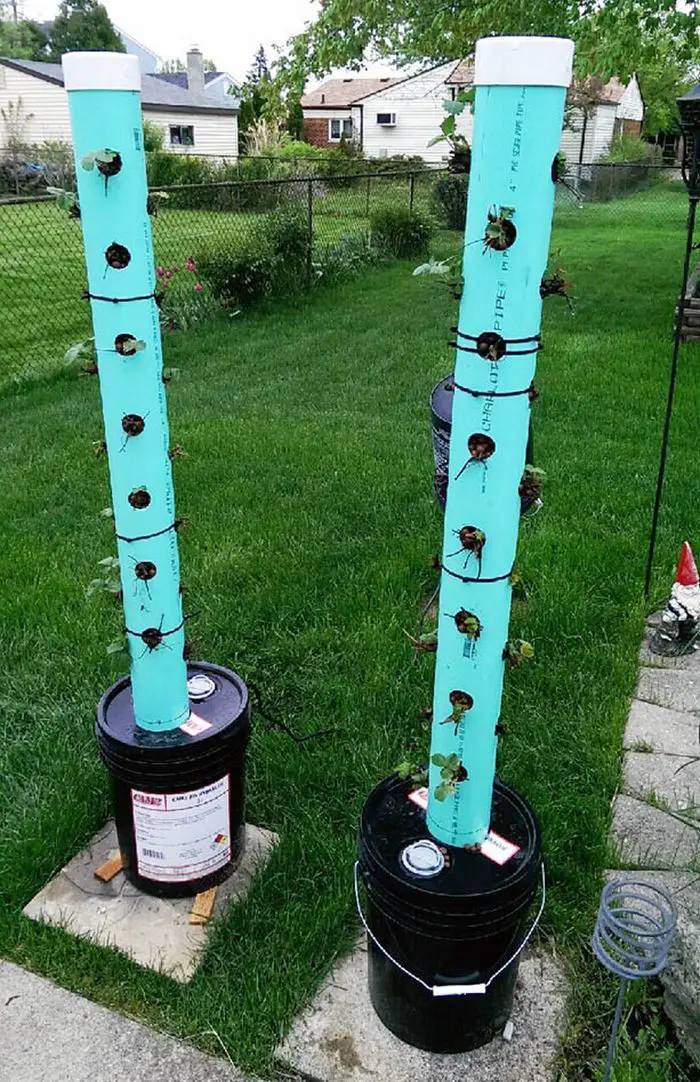
[adinserter block=”11″]
Click on any image to start the lightbox display. Use your Esc key to close the lightbox. 8-)



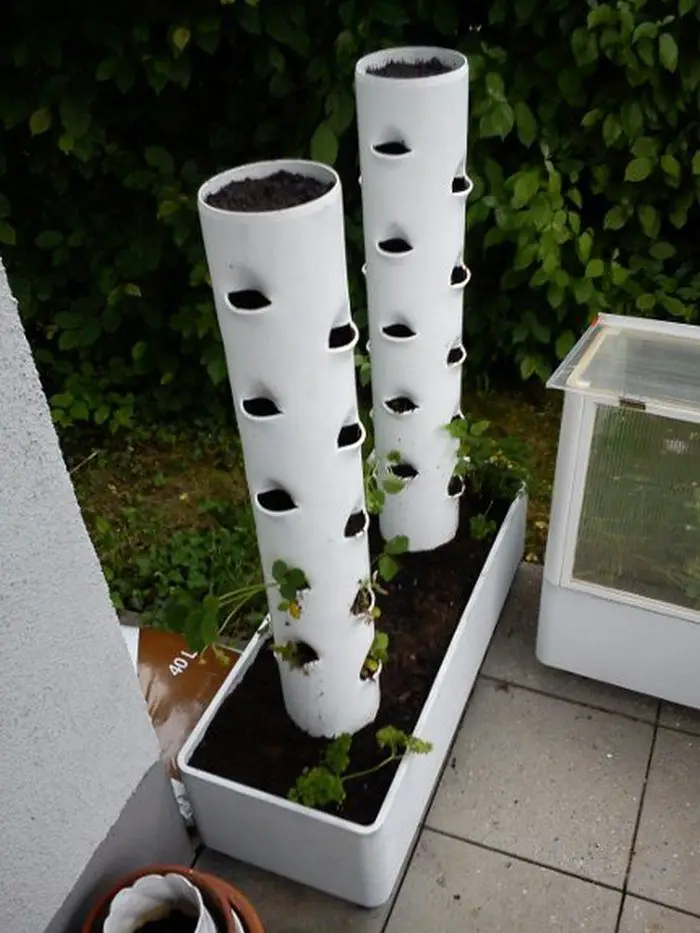

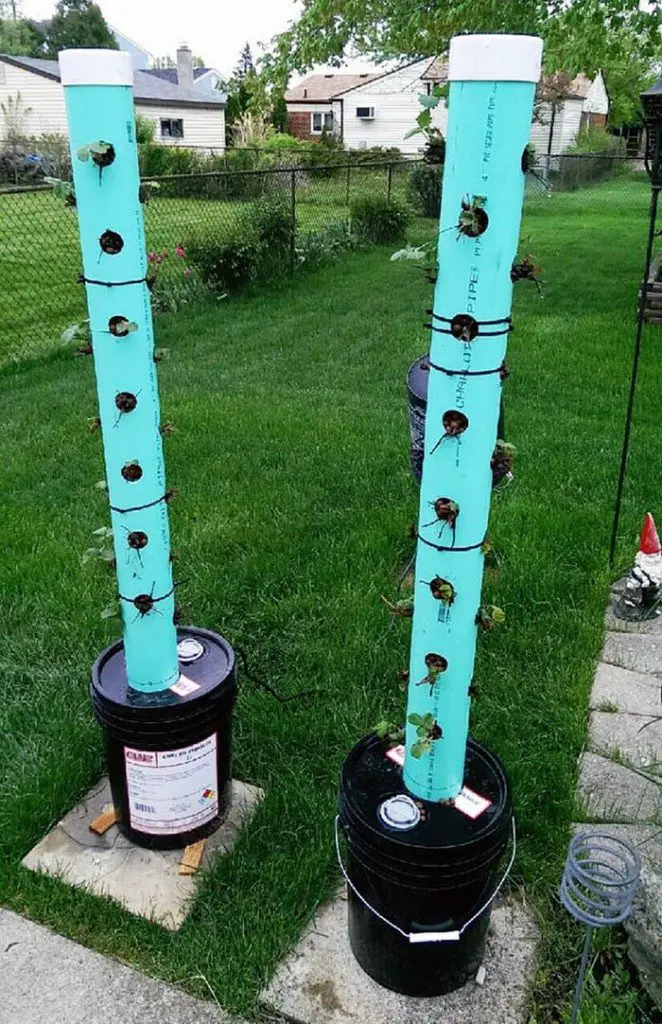
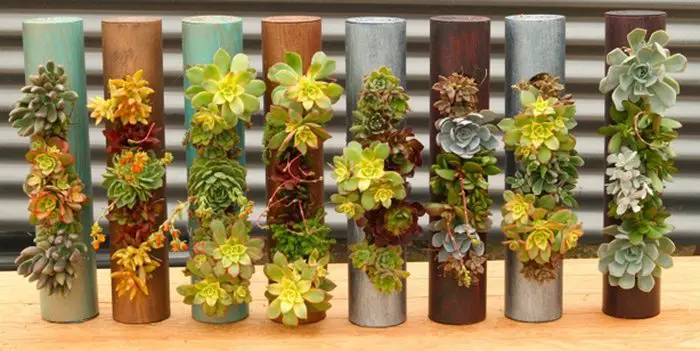
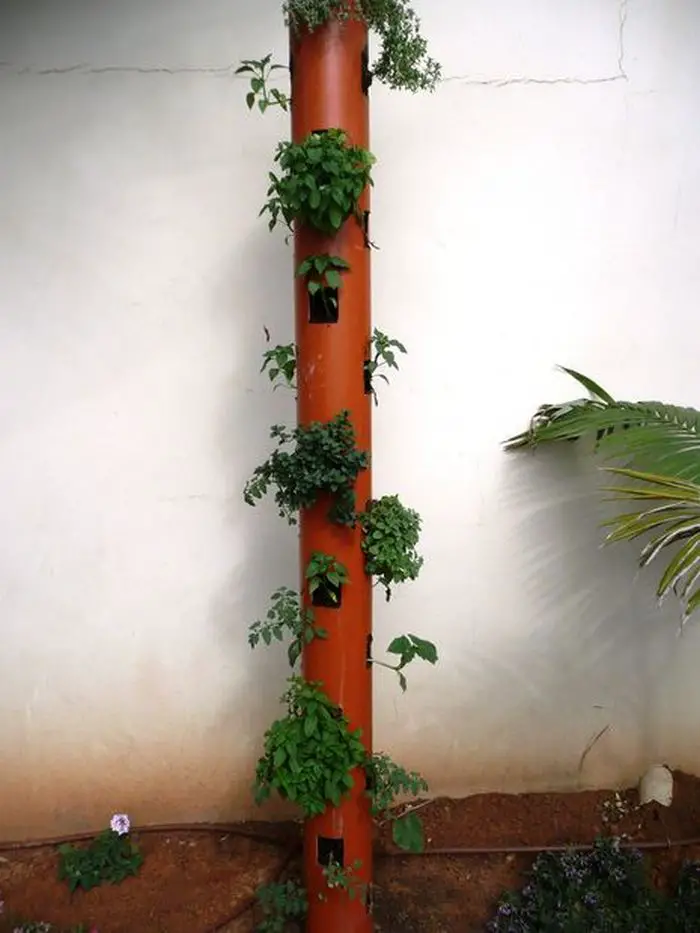
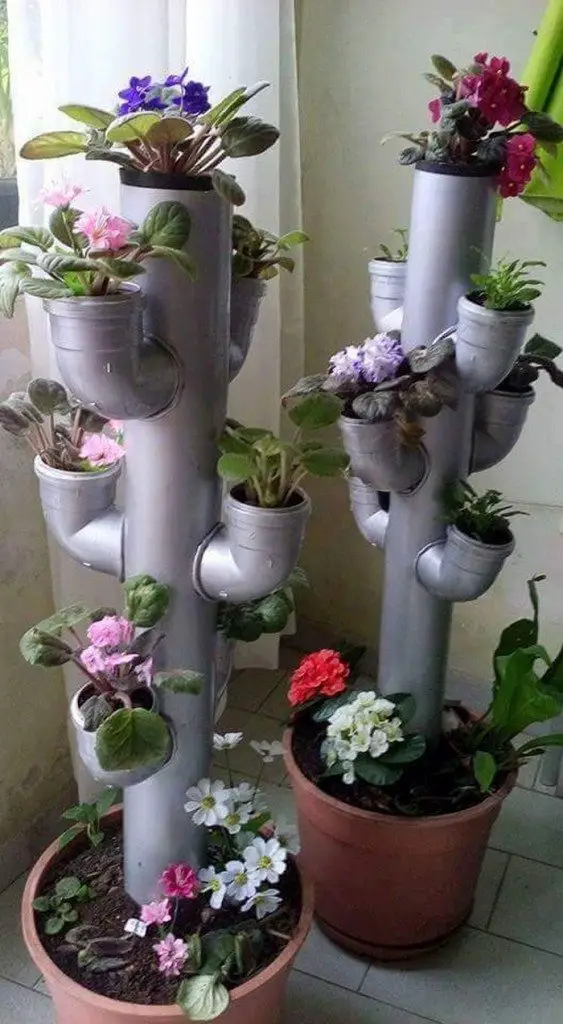
Here’s a step-by-step guide on how to make your own DIY PVC pipe planter.
Materials
- Any length 100mm-150mm (4″ – 6″) diameter PVC or any other kind of pipe
- Potting mix and compost
- Plants (not large plants or bushes)
- Large pebbles of about the same size for added support/stability
- A drip irrigation pipeline (or you can simply water from the top and it will trickle down)
Tools
- A drill and circular drill bit OR a jigsaw
- A hacksaw (if the pipe needs to be cut down)
- Marker pen
Important:
A minimum of 25% of your above-ground height needs to be below ground, to ensure stability. e.g. if you want your planter to be a metre high then the overall length of your pipe must be 125cm (or more).
Steps
1. Determine the number of holes in your DIY PVC pipe vertical planter. If you have an off-cut or leftover material from a previous project, the size and height of your current project are predetermined for you. If you are buying the materials you need to decide on the height and width of the pipe.
2. Decide how many holes you want in your planter. For a 100mm pipe, it is recommended to have only one hole in a horizontal row so the plants have enough room for their roots to grow.
For 150mm pipes, you can have up to 3 holes in each horizontal row depending on which plants you choose (three holes for flowers only, the rest either one hole or two).
3. Using a marker pen, mark out the holes you want to cut for your plants using the guidelines above. The size of the hole directly depends on the plants’ type and size.
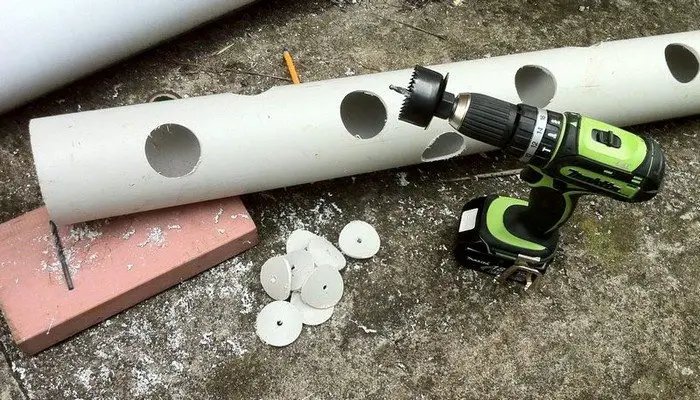
4. Using the markings, cut the planting holes using either a hand drill with a circular drill bit or a jigsaw.
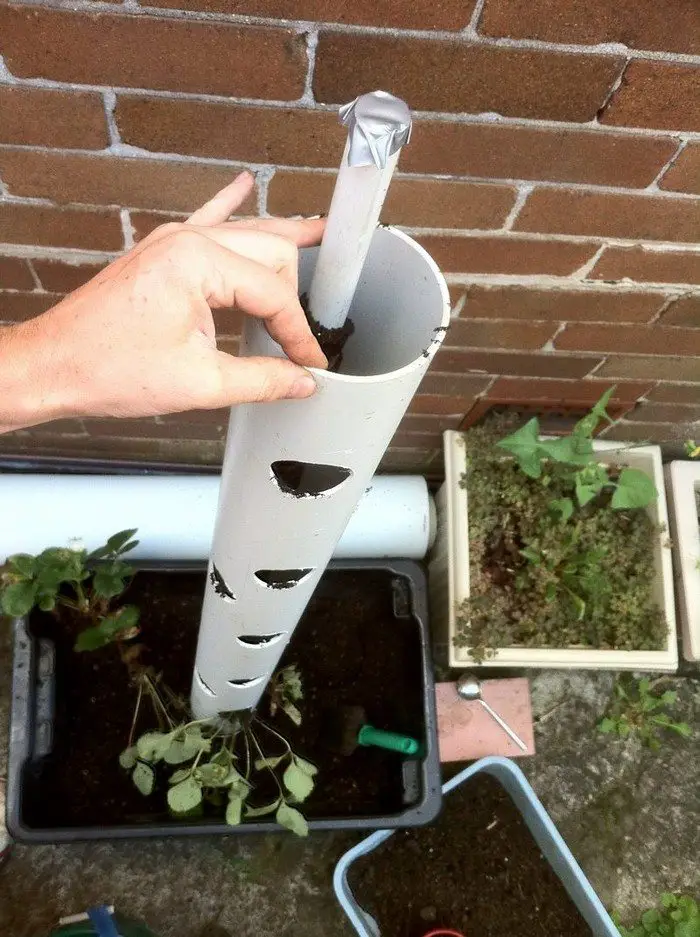
5. Place the pipe securely in a spacious container or right into the ground, ensuring stability by adding pebbles.
6. Finally, put the compost and soil into your pipe and start planting. Keep the water up to your plants and sit back and reap the rewards.
* Because the planters hold only a limited amount of soil, it is essential you keep the water up to your plants. If you are relying on watering only at the top of the pipe, you’ll find that the plants at the top will get plenty of water but those at the bottom will get a lot less dry.
That’s fine if you plant accordingly, but the best solution is to insert a weeper hose into the main pipe. This can be purchased or simply made by using a 1″ conduit drilled with weep holes down its length. Wrap this inner conduit in geo-fabric or weed-cloth to prevent it from getting blocked over time.
Benefits of Vertical Gardening with PVC Pipes
Vertical gardening is a smart and stylish way to maximize limited spaces while enjoying the benefits of gardening. Using a PVC pipe planter enhances this experience by providing a durable and versatile structure for growing a variety of plants. Here are some key benefits of employing PVC pipes in vertical gardening.
Space Efficiency
A PVC pipe vertical planter is an ideal solution for urban gardeners grappling with the challenge of limited space. By growing plants vertically, you can cultivate a lush garden on small balconies, patios, or in tiny yards without using up valuable ground area. This method allows you to maximize vertical space effectively, turning even the narrowest of spaces into vibrant green environments.
Cost-Effectiveness
PVC pipes are a cost-effective material for constructing garden planters. Compared to traditional planting methods and materials, a PVC pipe planter requires fewer resources and less investment. PVC is also readily available and easy to work with, making it an economical choice for DIY enthusiasts looking to build their own garden structures.
Versatility in Planting
The modular nature of a PVC pipe vertical planter allows for versatility in planting. You can easily design the planter to accommodate various plant sizes and types, from herbs and succulents to small flowers and vegetables. This flexibility makes it possible to tailor your garden to your specific needs and aesthetic preferences, whether you’re planting for beauty, utility, or a bit of both.
Accessibility
Gardening in a PVC pipe vertical planter makes the garden more accessible to everyone, including those with limited mobility. Since the planters raise the plants off the ground, gardeners do not need to bend or kneel to tend their plants. This setup is especially beneficial for older adults or individuals with physical limitations who still want to enjoy gardening without the strain.
Enhanced Plant Health
Vertical gardening with a PVC pipe vertical planter can lead to healthier plants. Elevating plants off the ground reduces their exposure to certain pests and diseases that are common in soil-based environments. Additionally, the vertical circulation of air around the plants can reduce fungal infections and promote healthier foliage due to better air circulation.
Incorporating a PVC pipe vertical planter into your gardening projects not only optimizes your growing space but also adds a modern touch to your home’s exterior or interior. By understanding and leveraging these benefits, you can create a functional and beautiful vertical garden that thrives even in the smallest of spaces.
Optimal Soil Mixtures and Nutrients for PVC Planters
Setting up your PVC pipe vertical planter with the right soil mix and nutrients is crucial. You want to ensure that your plants are healthy and thriving, right? Let’s break down what you’ll need.
Go for Lightweight and Well-Draining
For your PVC pipe planter, you’ll need soil that’s not too heavy and drains well. Mix one part peat moss or coconut coir with one part perlite and one part compost. This blend creates a perfect environment for your plants by keeping the soil light and breathable while ensuring it drains well. This combo keeps the soil airy and ensures excess water doesn’t stick around, which could harm your plant’s roots.
Keeping Moisture in Check
Vertical planters can dry out fast, so keeping moisture in the soil is crucial. Adding a bit of vermiculite or a hydrogel to your mix can help. This way, your plants will stay hydrated longer. It takes away the work you need to maintain your garden.
Regular Feeding with Balanced Fertilizer
Since the soil in a PVC planter can run out of nutrients quickly, a slow-release fertilizer with balanced parts of nitrogen, phosphorus, and potassium (N-P-K) is your best bet. It feeds your plants gradually and keeps them growing strong.
Don’t Forget the Micronutrients
Your plants also need a mix of smaller nutrients like calcium, magnesium, and iron. You can get these from a micronutrient mix or by adding compost to your soil. This ensures your plants get all the goodies they need to stay healthy.
Check the pH
Getting the pH right is crucial, too. Most plants like their soil slightly acidic to neutral, around 6.0 to 7.0. It’s a good idea to test your soil’s pH now and then. To keep things balanced, you can add lime if it’s too acidic or sulfur if it’s too alkaline.
With these tips, your PVC pipe vertical planter will be set up for success. Good soil and the right nutrients will make your garden full of life. Happy planting! Mix one part peat moss or coconut coir with one part perlite and one part compost. This blend creates a perfect environment for your plants by keeping the soil light and breathable while ensuring it drains well.
Creating Vibrant Vertical Gardens With PVC!
By repurposing PVC pipes, you can easily construct a vertical planter that maximizes your gardening area without taking up valuable ground space. This eco-friendly approach allows you to grow a variety of plants and herbs, even in limited spaces like balconies or small yards.
With step-by-step instructions and helpful tips, you’ll learn how to assemble your vertical planter with ease. From cutting the pipes to size and creating planting pockets to securing the structure, each stage of the process is explained in detail.
Not only does a DIY PVC pipe vertical planter provide a practical solution for maximizing space, but it also promotes sustainability. By repurposing materials, you contribute to reducing waste and minimizing your ecological footprint. It’s a win-win for both your garden and the environment.
Discover the joy of sustainable gardening as you create your own DIY PVC pipe vertical planter. Get ready to transform your space, grow a variety of plants, and embrace a more environmentally friendly approach to gardening.
By following this guide, you can begin an enriching journey to elevate your gardening experience. Get ready to witness your plants flourish in this innovative vertical planter, bringing both beauty and functionality to your green space.
Conclusion
Creating a PVC pipe vertical planter is an excellent way to utilize vertical space and add greenery to compact areas. This approach not only saves floor space but also elevates your gardening game, making it easier to maintain and harvest plants. Dive into this DIY project and transform your living space with a stylish and functional vertical garden.
FAQ: PVC Pipe Planter
- How do you plant starter plants in a PVC pipe vertical garden?
- Creating a PVC pipe vertical garden is a space-saving way to grow plants while adding greenery to small areas. Start by cutting your PVC pipe to the desired length, drilling evenly spaced planting holes along the sides and smaller drainage holes at the bottom. Secure the pipe vertically, fill it with soil, and carefully plant starter plants in the holes, ensuring their roots are covered. Position the garden in a spot with adequate sunlight, water thoroughly, and maintain it by trimming and removing dead leaves to keep your vertical garden vibrant and thriving.
- How do you add drainage holes to the irrigation pipe in a vertical garden?
- Adding drainage holes to your irrigation pipe ensures proper water distribution in a vertical garden. Start by selecting a 3/4-inch PVC pipe and using a drill with a 3/16-inch bit for precise and effective drainage holes. Mark evenly spaced points along the pipe, drill the holes carefully while maintaining a steady angle, and remove any jagged edges to prevent blockages. Test the pipe by running water through it, ensuring smooth and consistent flow, and set up a reliable irrigation system for healthy plant growth.
- How can you smooth out the edges of the holes in PVC pipes?
- Smoothing the edges of PVC pipe holes ensures safety and a professional finish. Start by wearing safety goggles and gloves, then use a metal file to gently remove rough edges with circular motions around the hole. For a finer finish, use medium-grit sandpaper wrapped around a small cylindrical object to sand the edges evenly. Finally, clean the area with a damp cloth to remove debris, leaving the surface smooth and ready for use.
- How do you make a vertical garden using PVC pipe?
- Creating a PVC pipe vertical planter is a simple and space-saving way to grow plants, ideal for small areas. Start by selecting a PVC pipe of 100mm-150mm diameter and cutting it to the desired length, ensuring at least 25% of its height is below ground for stability. Mark and cut planting holes using a drill or jigsaw, smooth the edges with a sanding file, and secure the pipe in a container or directly into the ground with added pebbles for support.
- Fill the pipe with compost and potting soil, add a drip irrigation system or water from the top, plant small starter plants, and maintain your vertical garden with regular watering, sunlight, and care to create a thriving and beautiful display.
- How should you add potting soil to a PVC pipe vertical garden?
- Fill your pipe with compost and potting soil, carefully inserting the mix while keeping the irrigation line centered and capped to maintain stability. It’s normal for some soil to spill out around the sides and base of the planter as you work. Once the pipe is adequately filled, top it off with mulch at the base to retain moisture and prevent soil erosion. Regularly water your plants, and soon you’ll enjoy the rewards of a flourishing vertical garden.
- How do you position the irrigation line in a PVC pipe vertical garden?
- Since vertical planters hold a limited amount of soil, maintaining consistent watering is crucial for healthy plant growth. Relying solely on watering from the top may leave lower plants dry, so the ideal solution is to use a weeper hose inside the main pipe. Create this by drilling weep holes into a 1-inch conduit and wrapping it with geo-fabric or weed cloth to prevent clogs. Place this irrigation line inside a larger central pipe, anchor it with six inches of gravel at the base for stability and drainage, and ensure it stays centered for even water distribution throughout your planter.
- What is the process for adding a weed block to a PVC irrigation pipe?
- To create a reliable irrigation system, start by drilling weep holes along the length of a 1-inch conduit or 3/4-inch PVC pipe. Wrap the pipe with geo-fabric or weed cloth to prevent blockages, securing the fabric with zip ties to keep it firmly in place. Seal both ends of the pipe with PVC caps to prevent debris from entering and obstructing water flow. This setup ensures consistent water distribution and reduces the risk of clogs, keeping your vertical garden healthy and hydrated.

